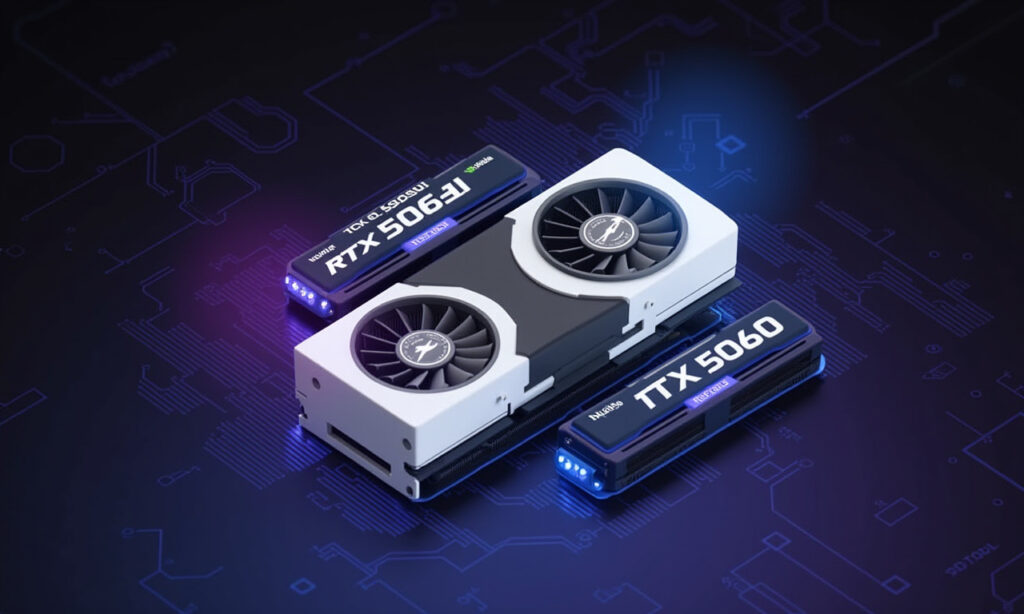Nvidia is gearing up to expand its RTX 5000 series GPU lineup with the upcoming RTX 5060 Ti and RTX 5060, but a recent leak has uncovered some interesting, if not slightly surprising, details about these new graphics cards.
The 128-Bit Memory Bus: A Blast from the Past
A leaked shipping manifest, as reported by VideoCardz, indicates that both the Nvidia GeForce RTX 5060 Ti and the non-Ti variant will utilize a 128-bit memory bus, which is the same width as their predecessors in the RTX 4000 series[1].
At first glance, this might seem like a step back, especially considering that other GPUs in the RTX 5000 series, such as the RTX 5070, boast a wider 192-bit memory bus. However, there’s more to this story than just the memory bus width.
The GDDR7 Advantage
The key highlight here is the transition to GDDR7 memory. Unlike the GDDR6 memory used in the previous generation, GDDR7 offers significantly higher speeds and bandwidth. This upgrade alone could provide a substantial performance boost, potentially offsetting the limitations of the 128-bit memory bus. The RTX 5060 is expected to come with 8GB of GDDR7 VRAM, while the RTX 5060 Ti will offer both 8GB and 16GB options[1].
Performance and Pricing: A Crucial Balance
While the specification leaks are intriguing, the ultimate success of these GPUs will hinge on their pricing and availability. The GPU market has been marred by issues of scalping, inflation, and high demand, leading to prices that are often far beyond the recommended retail price (RRP). If Nvidia can manage to keep the prices of the RTX 5060 Ti and RTX 5060 reasonable, it could be a significant win for budget-conscious gamers.
Leaked Prices: A Breath of Fresh Air?
Recent leaks suggest that the Nvidia GeForce RTX 5060 Ti could be priced at $399 for the 8GB model and $499 for the 16GB model, which are similar to the prices of the previous generation’s RTX 4060 Ti. This pricing strategy, if true, would be a welcome respite from the soaring costs of higher-end GPUs like the RTX 5090 and RTX 5080[5].
The User Experience and Practical Applications
For gamers on a budget, the RTX 5060 series could offer a compelling balance between performance and cost. With GDDR7 memory, these GPUs are likely to provide smoother gameplay and better graphics quality compared to their predecessors. Here are a few practical scenarios where these GPUs could shine:
- Budget Gaming: For those looking to upgrade from older GPUs or enter the world of modern gaming without breaking the bank, the RTX 5060 and RTX 5060 Ti could be excellent choices.
- Esports: The higher bandwidth and faster memory of GDDR7 could make these GPUs attractive for esports enthusiasts who need consistent high frame rates and low latency.
- Content Creation: While not as powerful as the higher-end models, these GPUs can still handle light to moderate content creation tasks like video editing and 3D modeling.
Challenges Ahead: Availability and Market Dynamics
Despite the promising specifications and pricing, Nvidia faces significant challenges in the current GPU market. Scalping, tariffs, and high demand have driven prices up, and unless Nvidia can ensure robust supply and control over retail pricing, these new GPUs may suffer the same fate as their more expensive counterparts.
In conclusion, while the decision to stick with a 128-bit memory bus for the RTX 5060 series might seem conservative, the adoption of GDDR7 memory and potentially competitive pricing could make these GPUs a compelling option for those looking for a balance between performance and affordability. As we await the official launch, one thing is clear: Nvidia needs a strong showing to regain momentum in a market that has been increasingly challenging for consumers.
